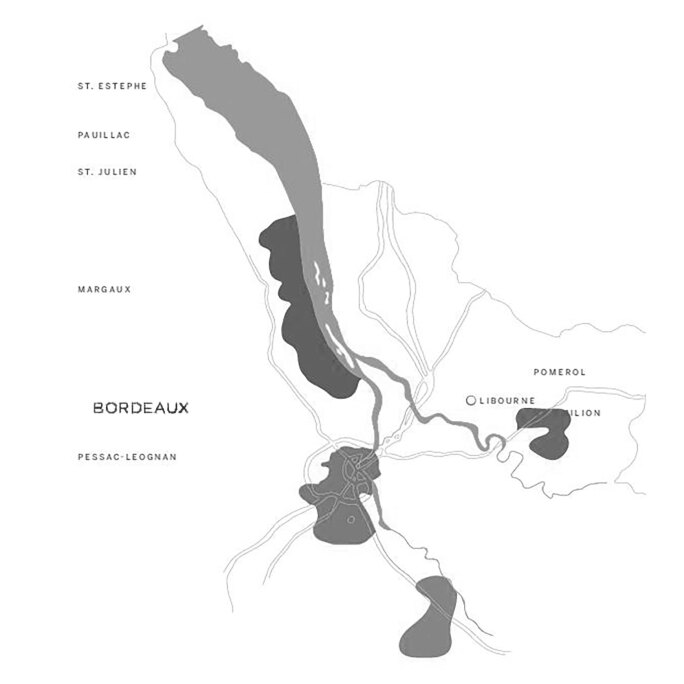B ordeaux is a singular region in France, yet there is great diversity among the famed wines produced there. This is a result of many factors including varietals grown, topography and soil, microclimate and the stylistic decisions made by the Châteaux themselves.
Sotheby's worldwide network of fine wine specialists regularly bring many of finest Bordeaux wine vintages to auction, across our global network of sale locations. In this essential primer we provide profiles of each of the key Bordeaux wine communes.
Left Bank vs Right Bank
The communes, or sub-regions, of Bordeaux are commonly divided between those on the left bank and right bank of the Girdonde Estuary and its two rivers, the Dordogne and the Garonne.
Left Bank
Located to the west of the Garonne, the most famous communes include:
- Saint-Estèphe
- Pauillac
- Saint-Julien
- Margaux
- Pessac-Léognan
- Graves
Right Bank
Situated to the east of the Dordogne, the most famous communes include:
- Saint-Émilion
- Pomerol

Saint-Estèphe
Saint-Estèphe is the northernmost of the six communal appellations in Médoc. The winemakers of this region produce red wines dominated by Cabernet Sauvignon and Merlot, often displaying earthy and savory aromas even in their youth. Saint-Estèphe wines are known for their distinct tannic profile, a result of a slightly cooler microclimate and a unique gravel and clay mixture in the soil.
Top Châteaux:
Pauillac
The Pauillac terroir is unique for the natural drainage provided by its gravel, ensuring dry, warm conditions for Cabernet Sauvignon to thrive. Young wines from this appellation tend to have a good tannic structure while displaying intensity, power and concentration of their fruit qualities, which results in remarkable ageing potential.
Top Châteaux include:
- Chateau Lafite Rothschild
- Chateau Latour
- Mouton Rothschild
- Pichon Lalande
- Chateau Pichon Baron
- Chateau Lynch Bages
Saint-Julien
Saint-Julien’s uniform gravel surface is underlined by a complex and varied clay and limestone subsoil that makes this Bordeaux wine commune’s production diverse. Saint-Julien wines fall between the powerful Pauillac and the elegant Margaux, and are known for their intense yet subtle notes of fruit and tobacco.
Top Châteaux include:
Margaux
Margaux is situated in a key area benefiting from the wine region’s mild winters and summers. The unique landscape of gravely hilltops along with the gravel- and pebble-rich soil encourage deep root growth and, therefore, high-quality grapes. The red wine from this region is known for its elegance and tends to have a floral perfume and a silky texture.
Top Châteaux include:
Pessac-Léognan
The finest wine-growing areas are located on slopes covered in distinct gravel, which consists of small stones of various types of quartz. This unique soil element provides a mineral quality to Pessac-Léognan’s famous red and white wines, and is particularly favourable to both Merlot and Cabernet Sauvignon, the main varieties making up the Haut-Brion and La Mission Haut Brion’s blends.
Top Châteaux include:
Sauternes
Sauternes, a small appellation within the Graves region, is world famous for its sweet white wines, most notably Chateau d'Yquem.
It is produced using Sémillon, Sauvignon Blanc, and Muscadelle grapes, made possible thanks to extremely rare climate and weather conditions that allow the growth of Botrytis cinerea. This type of fungi punctures grape skins during misty, humid mornings, followed by sunny, warm afternoons, which results in evaporation of the juice and concentration of sugars and flavour components in the grapes.
The best wines show intense notes of apricots, ginger, honeyed almonds, butterscotch, and, with age, caramel and dried apricots.
Top Châteaux include:

Saint-Émilion
Saint-Émilion is situated on a limestone plateau in the Right Bank. The chalky-clay makeup of the soils, offering a perfect balance between water-retention and drainage qualities, is particularly favourable to Cabernet Franc and Merlot. The resulting wines, when at their best, show powerful fruit character, velvety tannins, and finesse combined with a rounded body.
Top Châteaux include:
Pomerol
Pomerol is the smallest Bordeaux wine appellation with some of the smallest estates in the region – but it is also home to its most sought after and expensive wines. Merlot is the most famous grape here, grown extensively across the plateau. The iron-rich clay soils, known as crasse de fer, produce full-bodied red wines of extraordinary depth and showcase Merlot at its finest.
Top Châteaux include:
Buying and Selling Wine at Sotheby’s
Sotheby's is on hand to support as a trusted partner with your next wine purchase or consignment. Our global network of fine wine specialists bring thousands of vintages to market each year, all with assured provenance, across a range of different sale locations. Whether new to wine auctions or a longstanding oenophile, to partner with Sotheby's is to be part of a welcoming global community of wine collectors and enthusiasts.
- Browse all Bordeaux wine currently available for bidding
- Explore upcoming wine auctions across the globe
- Speak to our specialists about consigning your Bordeaux wine vintages
- Research your Bordeaux wine investment using our extensive sale archive
- Discover Bordeaux wines available for immediate purchase through our New York and Hong Kong retail sites
Trust our worldwide network of leading fine wine specialists from a globally renowned auction house with a 280 year history.














